Zucchini remains one of the most famous squash grown in the summer. While growing these plants, it is essential to learn the best time for planting for a successful harvest.
Zucchinis are summer crops and enjoy warm weather. To start the seeds outdoors, sow them 2-3 weeks after the last frost, when the temperature rises to 70-75°F. Indoors, sow them 1-3 weeks before the final frost and transplant them 2-4 weeks after the last frost.
Your living region’s temperature and climate highly influence the right time to start Zucchinis. But do not worry; we will share the right time to start them and explore different timings based on the zones.
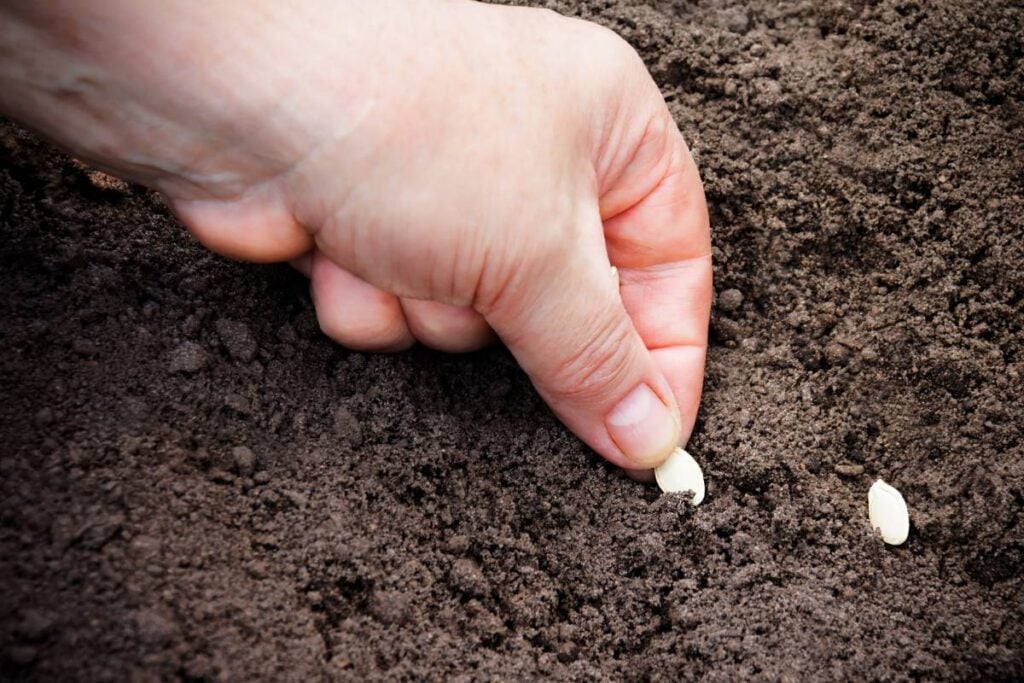
Understanding Your Growing Zone
Learning your Zone is essential when you plan to grow Zucchini.
Is your Zone capable enough to let the Zucchinis grow well?
No matter how much we take good care of the Zucchinis, it depends on different zones and the climate where it grows.
Zucchinis are summer crops and grow best in the warmer zones.
You can sow them directly outside.
You can even grow them in colder zones, provided you grow a suitable cultivar like Raven or Costata Romanesco.
Of course, you still need to protect it.
Start the seeds indoors to control the growing conditions and give them enough warmth inside your house for successful germination.
I belong to Zone 7 and sow them outside.
They grow at their best most of the time.
Zone 7 receives mild winters and warm summers, perfect for Zucchinis.
I have grown some cucumbers, Zucchini, eggplants, and sweet potatoes.
Besides this, I have also learned about the importance of microclimates within the zones.
Every Zone will have a different set of temperature ranges.
My Zone’s average minimum temperature is usually between 0°F and 10°F.
7a has a temperature between 0°F and 5°F, whereas 7b will have a minimum average of 5°F to 10°F.
Like this, every Zone will have different temperature ranges.
So, you must find that out for your Zone and start growing Zucchinis.
Determining Your Zone
Determining the USDA zones is easy because the internet knows it all.
But for your Zone’s exact condition, you need some research.
You need to learn the minimum and maximum average temperatures to determine whether Zucchinis will grow inside or outside and what varieties should suit your Zone.
The easiest method is:
Visit the https://planthardiness.ars.usda.gov/
- Enter your address or the zip code of your region.
- Refer to the color legend to determine the Zone.
- If you reach the edge of the hardiness zone, choose the colder one to be safe. For example, Texas and Lubbock will border the lime green 7b zone, and slightly darker green will be the 7a Zone.
Some detailed information:
- Visit your local gardening center, nursery, or agricultural extension office. They will inform you about the correct Zone and whether Zucchinis will be a good choice.
- Various gardening websites will allow you to input your ZIP code and determine the Zone. You will also know the right plants and vegetables to grow based on specific zones.
- Several gardening books are available that provide regional information and the growing zones. Check the local library or bookstore and find whether Zucchini is ideal for your Zone.
- Talk to some experienced gardeners and check YouTube videos by plant growers for valuable insights.
- While USDA zones are helpful, remember the microclimates. Urban heat, elevation, and proximity to water bodies can influence the type of climate in your region. For example, if you are in a warm zone and live in an urban area, you will receive more heat than in rural regions.
Planting Zucchini Seeds by Zone
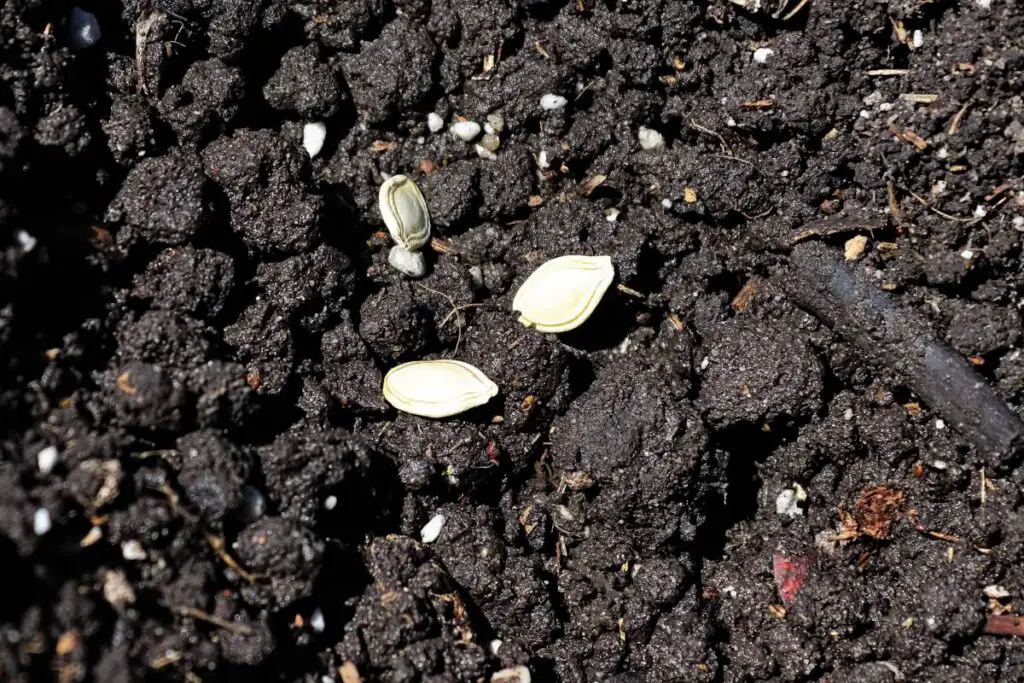
You need to plant the Zucchini seeds based on the temperature condition of your Zone.
As a rule of thumb, you must sow them when the soil temperature rises to 60-65°F after the last spring frost.
The exact timing, date, and month can differ for different zones.
Below, I am providing a small table about the planting zones and their dates:
| Zones | Estimated Last Frost | Sowing seeds indoors in Spring | Sowing seeds outdoors in Spring |
|---|---|---|---|
| Zone 3 | May 1 to June 10 | April 10 to April 25 | May 8 to May 23 or later, when you want |
| Zone 4 | April 24 to May 31 | April 3 to April 21 | May 1 to May 19 or later |
| Zone 5 | April 1 to April 30 | March 17 to April 9 | April 14 to May 7 or after some days |
| Zone 6 | March 30 to April 21 | March 11 to March 31 | April 8 to April 28 or later |
| Zone 7 | March 22 to April 30 | March 1 to March 7 | March 29 to April 10 or after some days |
| Zone 8 | February 20 to March 28 | February 21 to February 26 | March 20 to April 4 or later |
| Zone 9 | January 30 to February 28 | January 16 to February 7 | February 13 to March 6 or after some days |
| Zone 10 | No frosts | Early February | April 1 or later |
| Zone 11 | No frosts | Anytime | Anytime |
This is just a rough estimation. The dates and timing can be originally different, but there won’t be a huge difference.
Choosing the Right Time
When spring arrives and the ground thaws, we feel very excited and rush to plant the Zucchinis.
But this can make you lose your hard work.
A beginner’s common mistake is sowing seeds on the first day of spring when the sun shines bright, and the weather feels warm.
But the weather can do tricks, and suddenly, the temperature can become cold again.
So you need to choose the right time based on your Zone.
Start the Zucchini seeds indoors 2-3 weeks before the last frost in spring.
If you are directly sowing them outdoors or transplanting the seedlings, do it 2-3 weeks after the last frost in spring, after the ground thaws.
The soil temperature should be above 60-65°F. Use a soil thermometer for confirmation.
At the same time, the air temperature has to be above 70-75°F and the nighttime temperature above 40-45°F.
While trying not to plant them early, do not plant them too late.
Zucchinis are warm weather lovers and thrive under warm temperatures.
If you plant them too late, there are chances of frost approaching while they are still growing.
To avoid this:
- Plant 4-6 weeks before the first frost or earlier to let the plant develop and establish their roots.
- Give them protection if you suspect an upcoming frost with the help of row covers to keep them warm.
It takes 40 to 55 days for a Zucchini to mature. Keeping this in mind, the zones, and the last and first frost dates, you must choose the right time to sow the seeds.
It especially applies to gardeners who opt to sow the seeds directly outdoors.
Looking for gardening supplies? We have tested 100's of products before recommending them to you guys. Check out our best pick below:
| Image | Gardening Supplies | Best Price? |
|---|---|---|
 Top
Top Top
Top | Raised Garden Bed Kit | Check On Amazon |
 | XLUX Soil Moisture Meter, Plant Water Monitor, Soil Hygrometer Sensor for Gardening, Farming, Indoor and Outdoor Plants, No Batteries Required | No Results |
 Top
Top Top
Top | 82 Pcs Garden Tools Set and Extra Succulent Tools Set | Check On Amazon |
 | Joeys Garden Expandable Garden Hose with 8 Function Hose Nozzle, Lightweight Anti-Kink Flexible Garden Hoses, Extra Strength Fabric with Double Latex Core, (50 FT, Black) | No Results |
 Top
Top Top
Top | Dual Chamber Compost Tumbler | Check On Amazon |
 Top
Top Top
Top | Sunnyglade Plant Stakes | Check On Amazon |
 Top
Top Top
Top | Organic Cold Pressed Neem Seed Oil | Check On Amazon |
 Top
Top Top
Top | Mighty Mint Gallon :-Insect and Pest Control Peppermint Oil | Check On Amazon |
 Top
Top Top
Top | Scotts DiseaseEx Lawn Fungicide | Check On Amazon |
 Top
Top Top
Top | Jacks Classic 20-20-20 All Purpose Fertilizer | Check On Amazon |
 Top
Top Top
Top | 30,000 Seeds Pollinator Attracting Wildflower Mixture | Check On Amazon |
 Top
Top Top
Top | Survival Vegetable Seeds Garden Kit-Over 16,000 Seeds | Check On Amazon |
Succession planting
For Zucchini lovers, succession planting is one of the best methods to get endless Zucchini.
While Zucchinis are heavy growers, they also reduce their production level as they age.
With succession planting, you will receive baby and still-maturing plants when the old plants run out of fruits.
I typically consider succession planting with many vegetables, including Zucchinis.
I consider planting seeds every 2-3 weeks throughout the summer.
You can alternate the seedlings as close or spread them out, as per your choice.
Succession planting is excellent for areas with long Zucchini growing seasons and has no frost of at least 100 days or more.
Additionally, the areas should not be excessively cold.
Indoor sowing vs. Outdoor Sowing
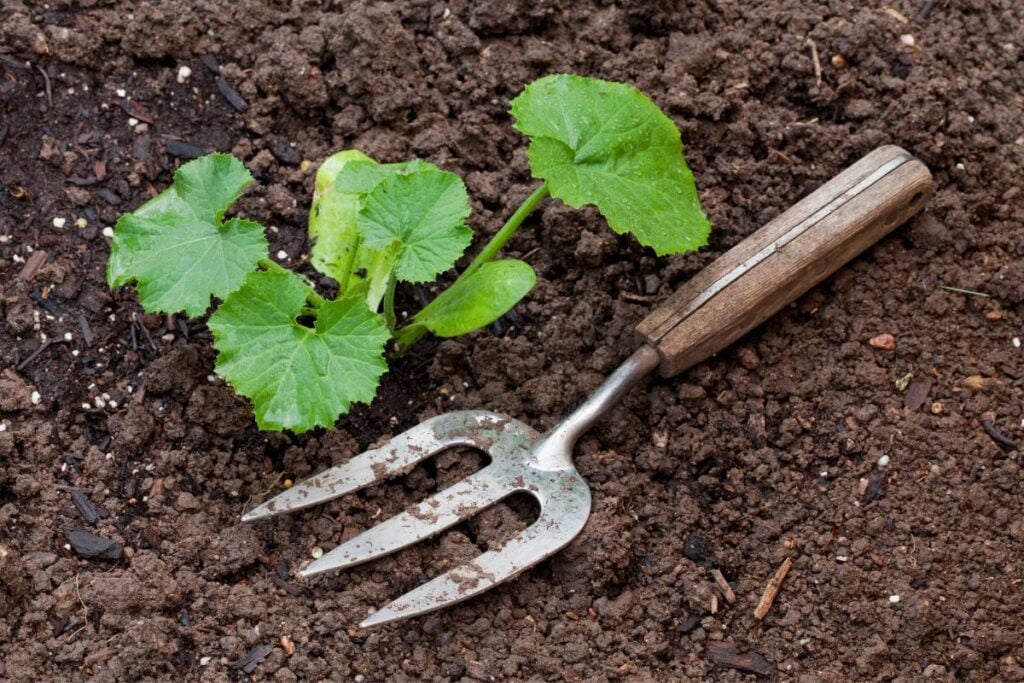
There are two ways to start the Zucchini seeds: Indoors and Outdoors.
Indoor seed sowing
This option is best if you live in the colder zones, for cold-season growers, and intermediate-level gardeners.
The method is primarily for Zones 2-6, where the weather is usually too cold.
Start the seeds indoors 2-3 weeks before the last frost.
All you need is a bit of preparation.
Sow the seeds in a germination tray or pot and then transplant them when the weather becomes warm.
To start the seeds indoors, find a good seed starting location.
This location will be a mini greenhouse.
Plant the Zucchini seeds in 3-4 inch square pots filled with good-quality seed starting mix.
Sow them ½ to 1 inch deep in the soil mix and put the pots on a bottom tray to let them catch the water.
Keep these starts evenly moist until they germinate.
It will take around 7 to 10 days if the soil is warm.
You can keep a heat mat beneath the trays for a warmer environment.
For lights, either keep them near the south-facing window or use Grow lights. Keep the lights 6-12 inches away from the stars.
After 2-4 weeks, the plants will germinate and grow true leaves and roots.
Harden off the transplants for a week.
Start keeping them outdoors for 1 hour and then bring them back, and every day, increase the timing.
Wait until the temperature becomes warm.
Transplant them 1-3 weeks after the last frost date.
Keep them on a protected sunny patio or an outdoor table with the row cover even after hardening for some weeks.
You can either transplant them in another pot and keep them outside like that or plant them directly in the ground.
Whatever your choice is, let the soil stay around the roots.
Take the plant off its current pot and transplant it without disturbing the soil around the roots, directly to another pot with the right soil mix, or to the ground.
I suggest keeping them in pots to bring them inside during a sudden or early frost.
You can check the soil preparation and mix recipes in our Zucchini soil requirement article, where we have shared everything in detail.
Pros
- You receive a head start on the season.
- The method is cheaper as you do not have to buy the nursery starts.
- You can grow different varieties of your choice.
- You have more control over the plant’s health and requirements.
Cons
- It can be time-consuming.
- Zucchinis are prone to transplant shock as they hate disturbing their roots.
- It will need a seed start-starting setup, which requires extra effort.
- You have to plan for hardening off the transplants.
Outdoor seed sowing
Like some Cucurbits cousins, Zucchini do not enjoy their roots getting disturbed.
Root disturbance can lead to transplant shock, further causing defoliation, yellowing, or stunted growth.
However, if taken proper care, these issues can be dealt with, and the plant will become healthy after some time.
That’s why most gardeners directly sow the seeds outdoors in the garden.
Direct seeding is better in regard to root health and the plant’s vigor.
It is the cheapest option that needs less handling or no special arrangements.
However, direct sowing can pose many risks, as unexpected frost can damage the young plants.
That is why it is better to approach direct seeding in the warmer growing zones with less pest pressure and reliably warm temperatures.
For direct seeding, wait until the soil temperature is above 60°F.
The air temperature should be above 40°F at night and 70-75°F during the day.
Direct seed sowing is ideal for Zone 7 through 11.
The weather stays warm most of the time, and Zucchinis receives a prolonged growing season.
Prepare a loamy, loose soil bed by adding some organic matter and then raking the soil flat.
Sow the seeds ½ to 1 inch deep and 12-18 inches apart.
Gently cover the seeds with soil and keep them evenly moist.
The seeds germinate around 7 to 10 days but can become more erratic while growing outside.
I prefer sowing extra seeds and then thinning them out by removing the weaker seedlings.
I also use row covers to protect the seedlings against unexpected temperatures and moisture extremes and exclude pests from the young plants.
Pros
- Cheap option
- Plants will thrive and vigor
- No risk of transplant shock
- No special arrangements are needed
- The least amount of handling is required
Cons
- Risk of rodents and soil-borne pests
- Can suffer due to unexpected temperature fluctuations
- Less control over the conditions
- Soil can dry out easily
- Late planting and harvest
These cons can be managed and prevented. Keep extra care of the young plants as they are more prone to damage during temperature fluctuations, and rodents will enjoy young soft plants.
Once the young phase passes, the plants will become resilient and strong and won’t be affected by these things.
Preparing the Soil
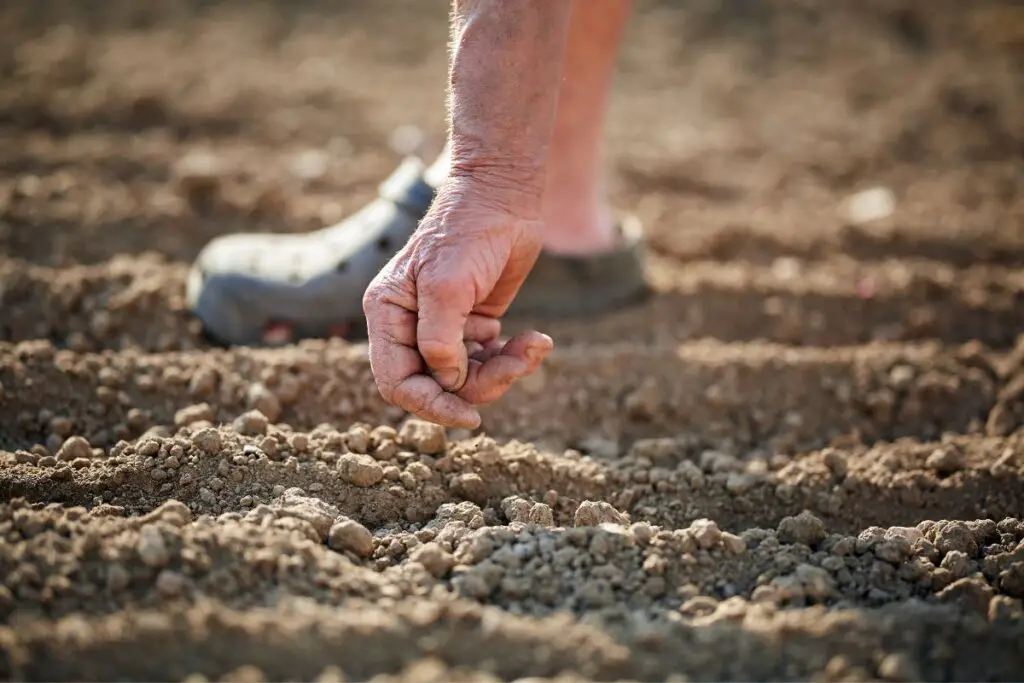
For the indoor seeds, you can use any seed-starting soil mix.
Additionally, you can change the soil mix while transplanting the young seedlings.
But for outdoor settings, there is no such option. You have to prepare it and make it ideal for the Zucchinis.
Make the soil loose, loamy, nutritious, and well-drained to provide the best environment for seed germination and plant growth.
To prepare the soil:
- Dig the top few inches of the soil bed and till it well. Break the soil lumps and remove the old plant remains and stones.
- Remove the weeds, too.
- Add 8 kgs of organic compost or whatever amount you require for the Zucchini bed. Growing the Zucchinis in raised beds would be best for better drainage.
- Mix the compost well, and again add some handfuls of fertilizer. I use chicken manure pellets. You can add a general purpose or any organic fertilizer.
- Mix them well, and plant the seeds 1 inch deep and 12-18 inches apart. You can keep the space now to remove the weaker ones after germination.
- Water the plant well, and keep the soil evenly moist throughout.
- Start fertilizing once the plant reaches 6-8 inches tall.
Frost Protection Measures
Although Zucchinis grow rapidly, they cannot tolerate cold weather conditions.
While Zucchinis takes around 45-55 days to mature, it will need completely frost-free and settled weather to thrive at its best.
Temperatures below 40°F will lead to stunted growth and also damage the crops.
These tender plants cannot tolerate cold or frosty weather.
You need to save them from frost.
You do not have to protect the Zucchinis in Zones 10 and 11 because these are warmer zones and rarely receive frost.
Zones 3-5 require a strong shield from frost as these are colder zones, and chances of frost or sudden frost are expected.
Zones 7-9 will also need protection, but not so much like the Zones 3-5. Zones 10-11 do not need it as they do not experience such frosts.
If the weather has played or you have miscalculated the time to sow the seeds or transplant the seedlings outdoors, there are a few things you can do:
- Place a plastic or frost cover over them to protect them during the late spring or early autumn frost.
- You can also use cloth row covers, plastic, or newspaper to protect them from the night frost and keep them insulated.
- Consider using a heavy type of frost blanket or row cover.
- You can buy frost protection 10-by-30 foot rolls from Sun Pro – Plant Covers Freeze Protection,10Ft x 30Ft Reusable Floating Row Cover,Freeze Protection Plant Blankets for Cold Weather (Support Hoops Not Included)
- If your plants need support for 1-2 nights, avoid using supports with hooks or cold frames.
- The covers should not flap around and damage your young plants. Anchor them with bricks or some heavy objects unaffected by freezing.
- While using plastic covers, ensure they do not touch the leaves, or the foliage will freeze.
- Remove the covers in the early morning every day when the sun hits the soil bed. Again, cover them during the frosty night.
- Add mulch around the plants to keep the moisture trapped and prevent the frosty temperature from reaching the seeds and growing roots of the young plants.
Care tips for successful Zucchini planting and growth
Once you have planted the seeds, you must take good care of the plant to receive vigorous plants filled with lots of fruits.
So, here are some care tips for a successful Zucchini growth:
- Planting the transplants in hills (elevated heaps of soil) will keep them warm when they reach 6 inches high and 12 inches wide. It encourages faster growth and good drainage, making it an ideal plant environment.
- Spacing plays a significant role because Zucchinis grow large leaves that need enough space and airflow to grow and breathe. Also, take into account the roots and the plant vines. Sow the seeds around 12-18 inches apart.
- Zucchinis need around 6-8 hours of sunlight for good germination and optimal growth. If you have covered your Zucchinis for frost protection, open the covers every morning for enough sunlight. Keep the indoor sown seeds near the south-facing window or use artificial Grow lights to control the light requirements. Keep them on for 12 hours and off for the rest 12 hours.
- Use well-drained loamy soil mixed with organic matter and a pH level between 6.5 and 7.0. Add lime or wood ash for lower pH and sulfur or gypsum for higher pH levels. Use a seed starting mix to sow the seeds indoors in pots. While transplanting them to another pot, use equal amounts of garden soil and well-rotted manure.
- After sowing the seeds, ensure the soil remains evenly moist, neither too wet nor too dry. Once the plant reaches 6-8 inches tall, gradually increase watering. Check the moisture level before watering. Whenever the top few inches have dried, water the plant.
- You have already added fertilizers before planting. You do not have to add fertilizers right after sowing. Once the plant reaches a few inches tall, fertilize with a mild, balanced liquid fertilizer. Use a 10-10-10 NPK fertilizer and apply them every 2-3 weeks for 8-9 weeks. Water the plant well before and after fertilizing.
Monitoring Growth and Adjusting
Once you have sown the Zucchini seeds and watered them, you need to check them regularly:
- Check the soil moisture and water it whenever the soil feels dry.
- Once the seeds germinate, check their growth habit and health regularly. Inspect their leaves, their growth speed, and other things.
- Check out for any pests and diseases. Check for signs of damage, like discolored leaves, eaten leaves, holes, and chewing signs. If you find any, troubleshoot by spraying neem oil or adding beneficial insects.
- Check the color and growth of your plant. It helps you understand the nutrient requirement. Fertilize your plant every 2-3 weeks when it has reached 6-8 inches tall. Even if you add compost, you should still feed your plant.
- Prune the plant to keep it healthy and safe. Pruning will improve the plant’s air circulation and shape if it becomes overgrown and crowded.
- Monitor the weather conditions, too. It can take a turn and give you another frost right after you have sown the seeds or the seedlings have just started. So, be cautious and protect your babies from frost by covering them with frost covers.
Harvesting Timeline
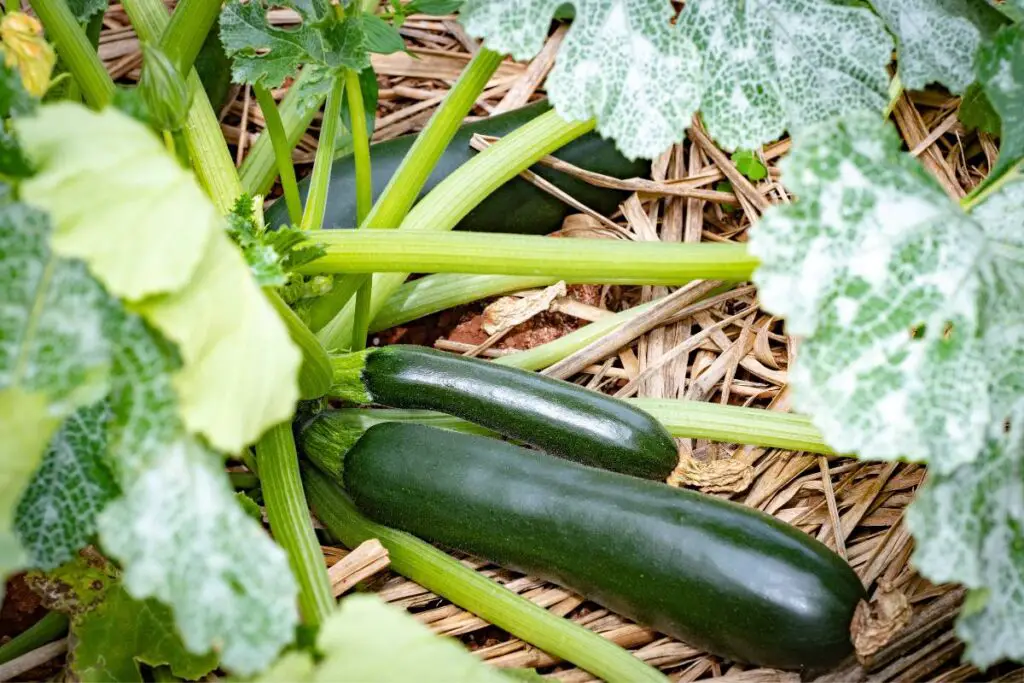
Expect your first Zucchini harvest 30 to 50 days from the moment you have planted the seeds.
You must keep monitoring, especially after the flowers appear to harvest the fruits.
For example, I am from Zone 7. When I sow the seeds in April, the Zucchinis get prepared for harvest around mid-May or June.
Inspect the fruits for the harvesting signs, like firm texture, dense Zucchinis with dark green color, etc.
Initially, the fruit growth will be slow.
But suddenly, it will accelerate.
So monitor and harvest them at the right time.
Look for signs in the fruit, like dark green color, firm and smooth texture, heavy weight, good density, 6-8 inches long, and 2 inches in diameter.
These signs conclude that Zucchinis are ready to pick.
At this stage, Zucchinis won’t be completely ripe.
But young Zucchinis are enjoyed better than the ripe ones.
Do not be too late.
Otherwise, the fruits will become hard to eat and have lots of seeds.
Harvest Zucchinis every day or every alternate day.
They are fast growers, and you can witness their growth speed overnight.
Hard Zucchinis may be challenging to eat, but you can still utilize them for cooking and saving the seeds for the following year’s sowing.
Use a pruner or a knife to cut the Zucchini fruits from the plant.
Leaving 1-inch steam in the fruit, cut the Zucchinis and collect them.
The stem will prevent rotting if you don’t want to consume the fruit.
Potential Challenges and Solutions
While growing the Zucchinis, you will face some challenges:
- Pests like aphids, squash bugs, beetles, and vine borers can attack the young Zucchinis. Inspect your plant regularly, use physical barriers, spray some neem oil every 2 weeks (after sunset) to keep them at bay, and add beneficial insects that love feeding on such bugs.
- Powdery mildew is a common disease caused by high humidity, lack of airflow, and high moisture levels resulting from insufficient space in between. Fortunately, neem oil can solve the issue. Keep enough space between the plants to prevent it.
- As a beginner, it is prevalent to underwater or overwater the plant, which further stresses the plant and affects the yields. Keep the soil evenly moist, neither too wet nor too dry. Always check the soil moisture by poking your finger. If the top few inches feel dry, water the plant; otherwise, wait some more time.
- Lack of pollination will result in no fruits. Encourage pollinators like bees and butterflies in your garden. Hand-pollinate them by collecting the pollen from the male flower with a brush or cotton swab and carrying and rubbing it to the female flower.
- Poor soil quality and lack of nutrition cause slow or stunted growth and lower yields. Test the soil’s fertility and amend it with organic matter like compost. Additionally, fertilize your plant every 2-3 weeks with a balanced liquid fertilizer.
- Extreme heat, cold weather, or unexpected frost and weather changes can highly stress your plant. If the weather is too hot and heated, cover them with shade and increase watering. Protect your plant from cold weather by mulching and adding frost covers at night.
- There will be competition for nutrients, water, and light if there are too many weeds around your Zucchini plants. As a result, your Zucchinis might have a slow or stunted growth. Remove all the weeds before and after planting and whenever you see them around your plant.
Final thoughts
The bottom line is to sow the Zucchini seeds when temperatures rise above 70-75°F after the last spring frost. If you are starting the seeds indoors in pots, start the seeds 2-4 weeks before the last spring frost and transplant them 2-3 weeks after the last frost. Sow the seeds directly to the ground outdoors 2-3 weeks after the last spring frost. Let the soil temperature rise above 60-65°F, the air temperature above 70-75°F, and the night temperature should be above 40°F.
If you still suspect a frost may come in your region while the seeds or transplants are outside, you can use frost or row covers to protect the plant from frost. Before planting, determine the ideal planting date according to your living zone. Determine the last frost dates and then think of sowing the seeds outdoors.
After planting, take good care of the plants by giving them adequate sunlight and enough water, planting good-quality soil, and giving enough fertilizers. Consider regular inspection to check for pests and diseases or any other signs of stress. Encourage pollination and harvest the fruits at the right time.
How late in the year can I start Zucchinis?
This entirely depends on the growing season of your Zone and the cultivar you grow. Based on the variety, it has a growing time of 45-55 days. Check the number of days for your cultivar and whether your Zone can provide perfect weather conditions.
How can I determine the last frost date?
Frost dates inform us about the upcoming spring weather. To find the last frost date, visit https://www.almanac.com/gardening/frostdates. Old Farmer’s Almanac is the most trusted source that helps you find out the frost dates. They prefer government-collected data from the NOAA National Center for Environmental Information.
Reference: Zucchini Wikipedia

